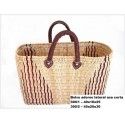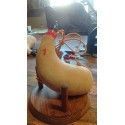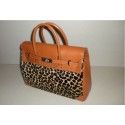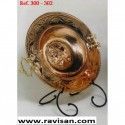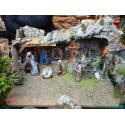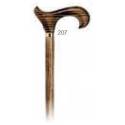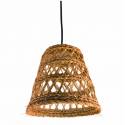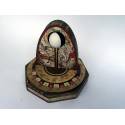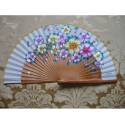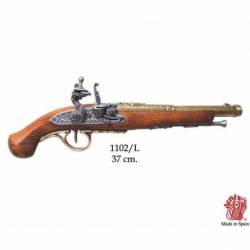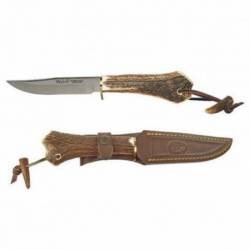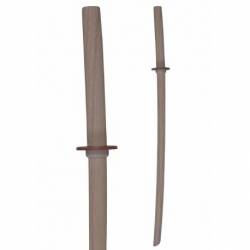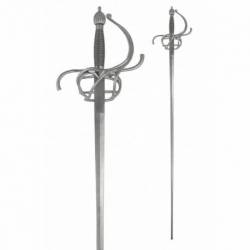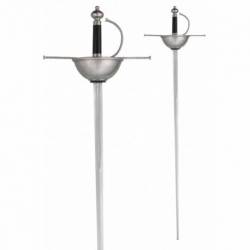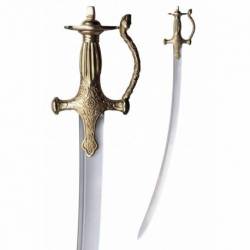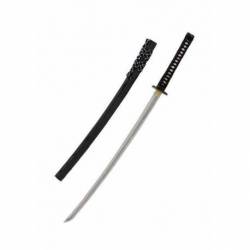El Abanico en España
Pese al creer popular, la existencia y uso del abanico en España no se remonta a épocas muy antiguas. Aunque si que es cierto que en su lugar se utilizaban otros instrumentos rígidos que ayudaban a mitigar el calor de nuestras tierras. Cuando hicieron su aparición los primeros abanicos plegables, éstos se introdujeron en Europa a través de España. La innovación que aportó el nuevo diseño fue rápidamente copiada y se inició su fabricación primero en España, y luego en el resto de Europa. Con todo, los maestros abaniqueros italianos y franceses superaron paulatinamente la factura española debido a la perfección con que trabajaban y a las medidas protectoras de sus respectivos gobiernos. En la actualidad, sin embargo, estos países ya hace tiempo que dejaron de fabricar abanicos, mientras que en España aún perdura la artesanía abaniquera.
La industria en España tuvo diversas dificultades hacia finales del siglo XVII, cuya causa principal fue la falta de perfección de innovación técnica con respecto a los otros países. En un menor grado fue también determinante la falta de protección del gobierno.
En tiempos de Carlos II se intenta remediar esta situación; en 1679 se quiere reforzar la industria abaniquera española, poniendo trabas a la entrada de abanicos de Francia e Italia y modernizando los talleres.
Bajo la protección del Conde de Floridablanca se instala en España un maestro francés, Eugenio Prost, con el fin de instalar una fábrica de donde salieron toda clase de abanicos con la misma calidad y diseños que los se confeccionaban en los otros países de Europa.
A finales del siglo XVIII ya se fabrican abanicos en toda España, aunque el mayor centro de producción estaba radicado en Valencia. También en este siglo se consolida un gremio de abaniqueros de ámbito nacional. La culminación de todos estos esfuerzos en favor de la industria abaniquera se produjo en el año 1802 con la inauguración de la Real Fábrica de Abanicos.
Al llegar el siglo XIX la industria del abanico en Levante es una de las primeras de Europa, cuya producción mostraba ya señales de declive. El uso del abanico en España estaba por entonces tan extendido que el escritor francés Teófilo Gautier llegó a escribir «nunca, he visto una mujer sin su abanico. La sigue a todas partes, hasta en la iglesia, las veo en grupos de todas las edades, arrodilladas o sentadas, con zapatos de tela, rezan y se abanican con el mismo fervor».
La influencia de la moda y la entrada de nuevas costumbres hacen que decaiga la demanda, pero aun así, por los condicionantes climáticos de España, ha perdurado el uso del abanico no sólo como elemento de adorno y moda, sino también por necesidad. De ahí que, no sólo sea utilizado desde siempre tanto por las mujeres como por los hombres, aunque éstos hasta principios del siglo XX utilizaban abanicos más pequeños que guardaban discretamente en los bolsillos de sus levitas.
En la actualidad, en el umbral del siglo XXI, existe una floreciente industria abaniquera que exporta a todo el mundo. El estilo de los abanicos que salen de sus talleres es muy variado, ya que recopilan y se inspiran en modelos que van desde los más antiguos hasta los que representan pinturas de los artistas más vanguardistas.
El Significado del Abanico:
Cuando las damas del siglo XIX y principios del XX iban a los bailes eran acompañadas por su madre o por una señorita de compañía, con el fin de que éstas velasen por su comportamiento.
Las señoritas de compañía eran muy celosas en el desempeño de la labor que se les encomendaba por lo que las jóvenes tuvieron que inventarse un medio para poder comunicarse con sus pretendientes y pasar desapercibidas.
Para ello usaban su abanico de diferentes maneras de modo que éste les servía de instrumento para pasar mensajes al galán que las cortejaba.
Gestos y significado
- Abanicarse rápidamente. Te amo con intensidad.
- Abanicarse lentamente. Abanicarse de forma pausada, significa soy una señora casada y me eres indiferente. También si se abre y cierra muy despacio significa esto.
- Cerrar despacio. Este cierre significa un “Sí”. Si se abre y cierra rápidamente significa, “Cuidado, estoy comprometida”.
- Cerrar rápido. Cerrarlo de forma rápida y airada significa un “No”.
- Caer el abanico. Dejar caer el abanico significa: te pertenezco.
- Levantar los cabellos. Si levanta los cabellos o se mueve el flequillo con el abanico significa que piensa en ti, que no te olvida.
- Contar varillas. Si cuenta las varillas del abanico o pasa los dedos por ellas quiere decir que quiere hablar con nosotros.
- Cubrirse del sol. Significa que eres feo, que no la gustas.
- Apoyarlo sobre la mejilla. Si es sobre la mejilla derecha significa “Si”. Sobre la mejilla izquierda es “No”.
- Prestar el abanico. Si presta el abanico a su acompañante, malos presagios. Si se lo da a su madre, quiere decir “Te despido, se acabó”.
- Dar un golpe. Un golpe con el abanico sobre un objeto, significa impaciencia.
- Sujetar con las dos manos. Si sujeta el abanico abierto con las dos manos, significa “es mejor que me olvides”.
- Cubrirse los ojos. Con el abanico abierto, significa “Te quiero”. Si se cubre el rostro puede significar “Cuidado, nos vigilan.
- Pasarlo por los ojos. Si se pasa el abanico por los ojos significa, Lo siento. Si cierra el abanico tocándose los ojos quiere decir, “Cuando te puedo ver”.
- Abrir el abanico y mostrarlo. Significa, “Puedes esperarme”.
- Cubrirse la cara. Cubrirse la cara con el abanico abierto, significa: Sígueme cuando me vaya.
- A medio abrir. Apoyar el abanico a medio abrir sobre los labios quiere decir “Puede besarme”.
- Apoyar los labios. Si apoya los labios sobre el abanico o sus padrones, significa desconfianza, “No me fío”.
- Pasarlo por la mejilla. Significa, “Soy casada”.
En esta sección de Artesanía en Ravisan, encontrará la categoría de abanicos realizados a mano y de muy buena calidad.
Fans:
The fan, as simple as it seems, goes through several specialized hands to complete its manufacturing process.
Depending on the material used, a different manufacturing process is followed. For wooden fans, the rods are first sawn and given the shape and thickness that we will need to complete the "package" that can be 12, 14, 16 ... up to 32 or even 40 rods. After an optional way, they are set, decorated and patterned and later they are woven, to move to the background painting phase where we will give the fan the desired color (in the case of the most common woods), the noble woods are polished to wear the natural mesh). It then passes into the hands of the artist-painter who decorates the piece, usually with flowers, landscapes or romantic figures. Later the wood is varnished or lacquered, to protect the paint and give it the brightness and finish chosen. The last hand consists of riveting the pins and adding a ring, if desired. After reviewing the entire process, our fan is finished and ready to be packed and sent to our customers.
In the plastic range, the process is completely different. The injected plastic linkage comes out with the corresponding mold shape and the desired color. It can be engraved or not with thermo printing, then we proceed to the weaving of the fan, and to sew the lace in the cases in which it is worn. With riveting and review, the manufacturing process is finished.
Fan Parts
The fan as we know it today, consists of two parts: the linkage and the country. The linkage is composed of a variable number of rods (always even), depending on the amplitude that you want to give the fan, and two guards that protect the fan when it remains closed. The most used materials are nacre, ivory, bone, different types of wood, including plastic materials. The fountain that is the visible part of the linkage located below the country, like the heads, is decorated with drafts, engravings, incrustations, polychrome, gold, etc. The straw or guide, which is the narrowest and thinnest part of the rod (in some cases a material poorer than the rest of the linkage), remains hidden between the two countries when it is double, and in view at the rear of the Fan when the country is simple. The clavillo is a thick wire that threatens the rods through holes drilled in them, and is riveted at both ends with the rosette and sometimes ring, so that the rods can not get out.
The country is an annular or semicircular sector, which serves to give coherence to the linkage. It can be made of cloth, paper, silk, etc., and it is usually decorated with paintings, engravings, embroidery, etc.
It should be noted for its peculiarity the range of cards, which has no country and is composed only of rods joined at the top by a narrow ribbon. The most commonly used materials are ivory, wood, bone, mother-of-pearl, etc., sometimes with drafts, engravings, paintings, incrustations, etc., and the ribbon is usually made of cotton or silk, in some cases decorated with painting.
The Fan in Spain
Despite believing popular, the existence and use of the fan in Spain does not go back to very ancient times. Although it is true that other rigid instruments were used instead to help mitigate the heat of our lands. When the first folding fans made their appearance, they were introduced to Europe through Spain. The innovation that contributed the new design was quickly copied and its manufacture began first in Spain, and then in the rest of Europe. All in all, the Italian and French master breadwinners gradually overcame the Spanish bill due to the perfection with which they worked and the protective measures of their respective governments. At present, however, these countries have long since stopped making fans, while in Spain there is still a fancier craftsmanship.
The industry in Spain had various difficulties towards the end of the seventeenth century, whose main cause was the lack of perfection of technical innovation with respect to other countries. To a lesser degree, the government's lack of protection was also a determining factor.
In the time of Charles II, an attempt is made to remedy this situation; in 1679 the Spanish airline industry was reinforced, putting obstacles to the entry of fans from France and Italy and modernizing the workshops.
Under the protection of the Conde de Floridablanca, a French teacher, Eugenio Prost, settled in Spain in order to install a factory from which all kinds of fans with the same quality and designs that were made in other European countries emerged.
At the end of the 18th century, fans were already manufactured throughout Spain, although the largest production center was based in Valencia. Also in this century, a guild of national-level airmen was consolidated. The culmination of all these efforts in favor of the fan industry took place in the year 1802 with the inauguration of the Royal Factory of Fans.
When the 19th century arrived, the fan industry in the Levant was one of the first in Europe, whose production was already showing signs of decline. The use of the fan in Spain was by then so widespread that the French writer Teófilo Gautier came to write "never, I have seen a woman without her fan. He follows her everywhere, even in the church, I see them in groups of all ages, kneeling or sitting with cloth shoes, praying and fanning themselves with the same fervor ».
The influence of fashion and the entry of new customs mean that demand declines, but even so, due to climatic conditions in Spain, the use of the fan has continued not only as an element of adornment and fashion, but also out of necessity. For that reason, not only be used always by both women and men, although these until the early twentieth century used smaller fans discreetly kept in the pockets of their Levites.
At present, at the threshold of the 21st century, there is a flourishing industry that exports to the whole world. The style of the fans that come out of their workshops is very varied, as they collect and are inspired by models that range from the oldest to those that represent paintings by the most avant-garde artists.
The Meaning of the Fan:
When the ladies of the nineteenth and early twentieth centuries went to the dances they were accompanied by their mother or by a young lady of company, in order that they would watch over their behavior.
The company ladies were very jealous in carrying out the work entrusted to them so the girls had to invent a means to communicate with their suitors and go unnoticed.
For this they used their fan in different ways so that it served them as an instrument to pass messages to the beau who wooed them.
Gestures and meaning:
1º.- Quickly fan. I love you with intensity.
2º.- Slowly fan. Abanicarse of slow form, means I am a married lady and you are indifferent to me. Also if it opens and closes very slowly it means this.
3º.- Close slowly. This closure means a "Yes". If it opens and closes quickly it means, "Look out, I'm engaged."
4º.- Close fast. Closing it quickly and angrily means a "No".
5º.- Fall the fan. Dropping the fan means: I belong to you.
6º.- Lift the hair. If you lift the hair or move the fringe with the fan means that it thinks about you, that you do not forget it.
7º.- Count rods. If you count the rods of the fan or run your fingers through them, it means you want to talk to us.
8º.- Cover yourself with the sun It means that you are ugly, that you do not like her.
9º.- Support it on the cheek. If it is on the right cheek it means "Yes". On the left cheek is "No".
10º.- Pay the fan. If he lends the fan to his companion, bad omens. If you give it to your mother, it means "I say goodbye, it's over."
11º.- Give a blow A blow with the fan on an object means impatience.
12º.- Hold with both hands. If you hold the open fan with both hands, it means "you better forget me".
13º.- Cover your eyes With the fan open, it means "I love you." If you cover your face it can mean "Be careful, they watch us.
14º.- Pass it through the eyes. If you pass the fan through your eyes it means, I'm sorry. If you close the fan by touching your eyes it means, "When I can see you".
15º.- Open the fan and show it. It means, "You can wait for me."
16º.- Cover your face. Covering your face with the open fan means: Follow me when I leave.
17º.- Half open. To support the half-opened fan on the lips means "You can kiss me".
18º.- Support the lips. If you support the lips on the fan or its patterns, it means distrust, "I do not trust".
19º.- Pass it down the cheek. It means, "I'm married."
In this section of Crafts in Ravisan, you will find the category of hand made fans of very good quality.



